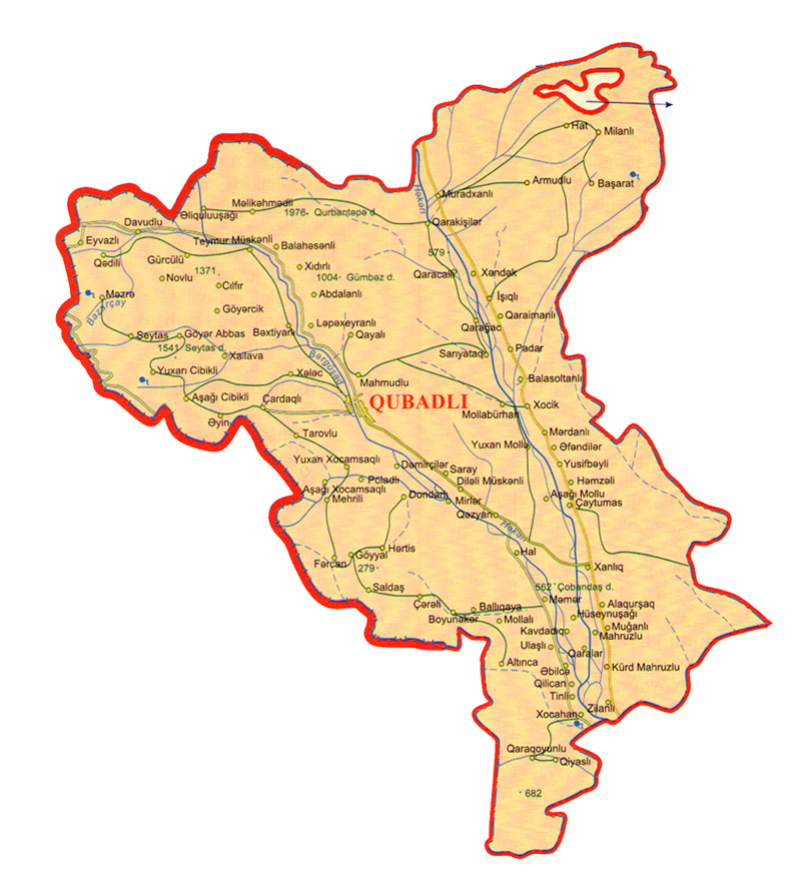


Gubadli region was formed on March 14, 1933. There was one city (Gubadli), 93 villages there, population is 41.6 thousand people (01.01.2020). The villages are: Ashaghı Jibikli, Khallava, Yukhari Jibikli, Balasoltanli, Garaimanli, Padar, Basharat, Armudlu, Deshdahat, Hat, Milanli, Chardagli, Eyin, Khaladge, Tarovlu, Chereli, Boyuneker, Saldash, Demirchiler, Poladli, Dondarli, Dileli, Muskenli, Mirler, Goyerjik, Əliquluuşağı, Fərcan, Göyyal, Hərtiz, Zor, Bəxtiyarlı, Saray, Hal, Ballıqaya, Qəzyan, Məmər, Mollali, Hemzeli, Chaytumas, Efendilər, Yusifbeyli, Khanlig, Khojahan, Gilijan, Tinli, Khochik, Mardanli, Garajalli, Garaghadge, Garakishiler, Garalar, Huseynushaghi, Kavdadiq, Gayali, Abdalanlı, Ləpəxeyranlı, Mahmudlu, Mahruzlu, Muradxanlı, Muğanlı, Məlikəhmədli Qundanlı, Alagurshag, Davudlu Eyvazli, Gurjulu, Gadili, Mazra, Sariyatag, Tatar, Garagoyunlu, Giyasli, Teymur, Muskenli, Balahesenli, Khidirl, Ulashli, Altinja, Ebilje, Yukhari Khojamsagliı, Ashaghi Khojamsagli, Mehrili, Yukharu Mollu, Ashaghı Mollu, Mollaburhan, Zilanli, Kurd Mahruzlu, Seleli, Novlu, shigli, Hekeri, Gilfir, Seytas, Goyar Abbas,Khendek.
The distance between Gubadli and Baku is 403 km. It is located in the south-west of the Azerbaijan Republic, in the south-east of the Karabakh plateau. It shares a 120-km border with Armenia, a 45- km border with Khojevend. Gubadli also borders on Lachin, Jabrayil, and Zangilan regions.
The nature of Gubadli region is very beautiful. In 1969 state natural reserve was established there. There was a 13,160-ha national forestry fund in the region with different types of trees. Oak trees were the protector, hornbeam trees were the wealth, apple, pear, nut, medlar, cornel, hawthorn trees were the riches, mountain rivers, waterfalls, icy springs wre the fame, black-eyed gazelles, partridges, pheasants, francolins, pigeons were the beauty of these forests. Two big mountain rivers flow through the region— the Hakari and Bargushad rivers. The Hakari River takes its beginning from Kalbajar region. Some mountain rivers join it until the Hakari flows into the Araz.
The Bargushad River takes its beginning from Erikli Mountain. The Bargushad gets its strength from the Delichay, Sheki, Sisiyan, Takhtakorpu, Dashli dere, Bakhtiyarli and Agha Rivers that take their sources from mountain springs. The Bargushad River also flows into the Araz like the Hakari River. Both rivers interflow near the village Garalar of Gubadli region.
Though one part of the region is lowland, the main part is mountainous. Mountanous areas are covered with forests. Lifegiving springs in Hartiz and Senger Mountains of the region are considered to be remedy. The people in Gubadli were engaded in cattle breeding, tobacco-growing and grain –growing. Thre was unused agate deposit in Gubadli. There was marble resource there as well.
Gubadli and its surrounding villages were included in the administrative territory of Nagorno-Karabakh in XVIII century. Later, Gubadli which was the composition of the Zangazur province, was included in Zangazur in 1868 after the establishment of the Yelizavetpol province. Gubadli borders on Gorus, Gafan regions of Armenia, and Zangilan, Jabrayil, Lachin, Khojavend regions.
Gubadli city is situated in the south-east of Karabakh plateau, on the bank of the Bazarchay River. 62 offices and enterprises were operating in the city. There was one asphalt plant, an incubator- poultry farm, stone quarry, technical supply department, clothes factory, a branch of Azerbaijan “Neftqazavtomat” experimental plant and other industrial enterprises there.
In Gubadli region there were 21 general secondary schools, including 26 eight-year schools, 15 primary schools, 1 part-time school. Every year 300 students gained various professions at technical vocational school № 126 in the village of Khanlig.
Four hospitals with 685 beds, 33 medical centres were functioning in Gubadli. 111 cultural-educational institution, 60 libraries, 10 cultural centres, 28 libraries, 6 auto-clubs, 23 film projectors served people in the region. 125 trade, 96 public-caterings, 25 domestic service enterprises functioned in Gubadli.
There were 21 communication facilities in the region. In Gubadli settlement 1200- nurmbers ATS, in Muradkhanli and Hal villages a 150 –numbers ATS for each, in Teymur Muskanli, Balasultanli, Chardakhli, Ashaghi Molla villages 100 –numbers ATS for each, in Gayali village 50-numbers ATS were functioning.
Gubadli region was occupied by armed forces of Armenia on August 31, 1993. Before the occupation tens of new public and residential buildings, gardens, avenues, squares, and bridges had been built, roads had been constructed in the villages and settlements. There was a secondary school for 1176 students in the settlement, a 422-students school for each of the villages Chapali, Dondarli, Mahruzl, a 325-students school in Muradkhanli village, in Balasoltanli, Chardakhli and Garajalli villages a 192-students school for each, in Gayali village a secondary school for 216 students, a 192-seats school for each of the villages Demirchiler, Khandek, a 164 –seats eight-year school in Garakishiler, Tarovlu, Ashaghi Khojasamli villages for each, primary schools in Mardanli, Padar, Giyasli, Abdalanli, Marlar villages. All these schools had ben constructed before the occupation.
New modern hospital, ATS, trade center, department store, super markets, bazaar, hotel, bookstore in the city centre, a clinic in Mahruzlu in village, out-patient’s clinic in the village of Garalar, library buildings inKhojic Ishigli, Dileli and Muskanlı villages had also been constructed prior to the occupation.
Before the occupation of the region the new asphalt and highways were constructed and threy connected the town with Aligulushaghi, Hekeri (Zangelan region), Khanlig, Ayin, Fardgan, Mirler, Demirchiler, Hartiz, Charali, Muradkhanli, Garajalli, Eyvazli and Yukhari Mollu villages, also old roads were expanded. Khanlig-- Yukhari Mollu, Ulashlı--Mahruzlu, Gazyan-Khojahan and other rural roads had completely changed their previous view. Gubadli-Dondarl, Sariyatag-Padar, Gralar-Mahruzlu, Teymur Muskanli-Balahesenli, Mahmudlu-Hajili Bridges not only joined the wistful bank also inspired the visitors. A guesthouse built in “paradise” Armudlu garden that was situated in a life-giving corner of Senger Mountain pleased everyone. The people of Gubadli continued renovation and construction work with enthusiasm.
25 October 2020 - the city of Gubadli was liberated from Armenian occupation, as were 41 villages in the region during the Second Karabakh War. Azerbaijani sovereignty was established over Gubadli region, and the territorial integrity of the Republic of Azerbaijan was restored. Zengezur is Azerbaijan!
Source:
Book Karabakh Memory,Baku- 2010. MHS- poligraf
Information of State Statistics Committee.